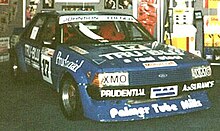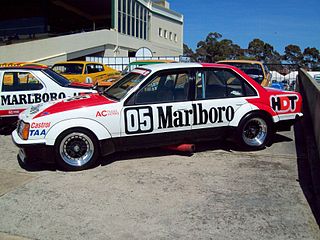Teams and drivers




The following teams and drivers competed in the championship:
The 1982 Australian Touring Car Championship was a CAMS sanctioned Australian motor racing title open to Group C Touring Cars. [1] It began on 18 February 1982 at Sandown Raceway and ended on 16 May at Oran Park Raceway after eight rounds. [2] The title, which was the 23rd Australian Touring Car Championship, was won by defending champion Dick Johnson, driving a Ford XD Falcon.
Peter Brock had actually scored more points than Johnson throughout the championship driving Marlboro Holden Dealer Team entered Holden Commodore VC and VH SS models. However, the use of not yet homologated engine heads on the cars saw him disqualified from all but two rounds of the championship. The matter between CAMS and the HDT ended in court with Brock agreeing to the loss of points and the championship to avoid a three-month suspension for himself and the team which would have actually excluded them from competing in the James Hardie 1000 at Bathurst.
Allan Moffat's win in Round 5 at Lakeside with a Mazda RX-7 was the first ever ATCC race win by a Mazda and the first ever ATCC race win by a Japanese car. It was also the first ATCC race to be won by a car not powered by a V8 engine since Peter Brock's victory in Round 4 of the 1974 championship at Amaroo Park driving a 6 cylinder, Holden LJ Torana GTR XU-1.
Under 3000cc class competitor Bob Holden finished second in the championship driving a Ford Escort Mk.II. Though he would finish no higher than 8th outright in any race, points scored for class placings saw him finish second on 36 points, 21 behind Johnson and 5 points in front of both Moffat and Kevin Bartlett (Chevrolet Camaro Z28).




The following teams and drivers competed in the championship:
The championship was contested over an eight-round series. [12] The Sandown round was contested over two parts and all other rounds were contested as single races. [2]
| Rd. | Race / circuit | Location / state | Date | Winner | Team | Report |
|---|---|---|---|---|---|---|
| 1 | Sandown Sandown International Raceway | Melbourne, Victoria | 17–18 Feb | Dick Johnson | Palmer Tube Mills | |
| 2 | Calder Calder Park Raceway | Melbourne, Victoria | 27–28 Feb | Dick Johnson | Palmer Tube Mills | |
| 3 | Symmons Plains Symmons Plains Raceway | Launceston, Tasmania | 6–7 Mar | Peter Brock | Marlboro Holden Dealer Team | |
| 4 | ARCO Cup [13] Oran Park Raceway | Sydney, New South Wales | 20–21 Mar | Kevin Bartlett | Nine Network Racing Team | |
| 5 | Lakeside Lakeside International Raceway | Brisbane, Queensland | 3–4 Apr | Allan Moffat | Peter Stuyvesant International | |
| 6 | Walpamur Cup [13] Wanneroo Park | Perth, Western Australia | 27–28 Apr | Allan Grice | Re-Car Racing | |
| 7 | Mazda Dealers of South Australia Race [13] Adelaide International Raceway | Virginia, South Australia | 1–2 May | Dick Johnson | Palmer Tube Mills | |
| 8 | Surfers Paradise Surfers Paradise International Raceway | Surfers Paradise, Queensland | 15–16 May | Allan Moffat | Peter Stuyvesant International |
Note: Brock was excluded from Calder and lost all points from Oran Park to Surfers Paradise, however, kept the Symmons Plains win. [12]
Cars competed in two engine capacity classes:
Note: Mazda RX-7s fitted with bridge port engines competed in the Up to and including 3000cc class and those fitted with peripheral port engines were re-classified into the 3001 to 6000cc class.
Championship points were awarded on a 9–6–4–3–2–1 basis to the first six placegetters in each class at each round. [1] Bonus points were awarded on a 4–3–2–1 basis to the first four placegetters, irrespective of class, at each round. [1] Results from seven of the eight rounds could be retained by each driver. [1]
Note: Round results indicate outright round placings, not class placings.
Allan George MoffatOBE is a Canadian-born Australian racing driver known for his four championships in the Australian Touring Car Championship, six wins in the Sandown 500 and his four wins in the Bathurst 500/1000. Moffat was inducted into the V8 Supercars Hall of Fame in 1999.
The 1988 Australian Manufacturers' Championship was an Australian motor sport title authorised by the Confederation of Australian Motor Sport (CAMS) for Group 3A Touring Cars. It was the 18th circuit racing manufacturers championship to be awarded by CAMS and the ninth to be contested under the Australian Manufacturers' Championship name.
The 1981 Australian Touring Car Championship was a CAMS sanctioned motor racing title for drivers of Group C Touring Cars. The championship, which was the 22nd running of the Australian Touring Car Championship, began at Symmons Plains Raceway and ended at Lakeside International Raceway after 8 rounds.

The 1982 James Hardie 1000 was the 23rd running of the Bathurst 1000 touring car race. It was held on 3 October 1982 at the Mount Panorama Circuit just outside Bathurst in New South Wales, Australia. The race, which was Round 3 of both the 1982 Australian Endurance Championship and the 1982 Australian Endurance Championship of Makes, was open to cars eligible to the locally developed CAMS Group C touring car regulations with two engine capacity based classes.
The 1979 Hang Ten 400 was an endurance motor race held at the Sandown Park circuit in Victoria, Australia on 9 September 1979. It was staged over 129 laps of the 3.11 km circuit, a total of 401 km. The race was Round 1 of the 1979 Australian Championship of Makes and as such it was open to Group C Touring Cars. It was the fourteenth in a sequence of annual Sandown long distance races. The race was won by Peter Brock.
The 1988 Australian Touring Car Championship was a CAMS sanctioned motor racing title for drivers of Group 3A Touring Cars. It was the 29th running of the Australian Touring Car Championship. The championship began on 6 March at Calder Park Raceway and ended on 17 July at Oran Park Raceway after nine rounds.
The 1986 Australian Touring Car Championship was an Australian motor racing competition for Touring Cars. It began on 2 March 1986 at Amaroo Park and ended on 13 July at Oran Park Raceway after ten rounds. The championship was authorised by the Confederation of Australian Motor Sport (CAMS) as an Australian National Title. It was the 27th Australian Touring Car Championship and the second to be contested by cars conforming with CAMS regulations based on the FIA's international Group A Touring Car regulations.
Peter Gerard McLeod is a retired Australian racing driver, best known as co-winner of the 1987 James Hardie 1000 at Bathurst, and for driving the distinctive yellow and black Slick 50 Mazda RX-7 Group C touring car during the early to mid-1980s.
The 1984 Australian Touring Car Championship was a motor racing competition for Group C Touring Cars. The Championship was authorised by the Confederation of Australian Motor Sport as an Australian National Title. It was the 25th Australian Touring Car Championship, and the last to be contested by Group C cars as new regulations, based on international Group A, were introduced for 1985.
The 1985 Australian Touring Car Championship was a CAMS sanctioned motor racing title for drivers of Touring Cars. It was the 26th running of the Australian Touring Car Championship and the first to be contested using regulations based on the FIA's International Group A regulations after having been run under CAMS home grown Group C rules between 1973 and 1984. The championship began on 10 February 1985 at Winton Motor Raceway and ended on 14 July at Oran Park Raceway after ten rounds.

The 1983 Australian Touring Car Championship was a CAMS sanctioned motor racing title for drivers of Group C Touring Cars. The title, which was the 24th Australian Touring Car Championship, was contested over a series which began on 6 February 1983 at Calder Park Raceway and ended on 19 June at Lakeside International Raceway after eight rounds.
The 1977 Australian Touring Car Championship was a CAMS sanctioned Australian motor racing championship open to Group C Touring Cars. It was the 18th running of the Australian Touring Car Championship. The championship began at Symmons Plains Raceway on 7 March and ended at the Phillip Island Grand Prix Circuit on 20 November after eleven rounds. 1977 was the second and final time that the series incorporated the longer distance races which made up the Australian Championship of Makes. These races included the Sandown 400 and the Phillip Island 500K, although notably not the Bathurst 1000.
The 1972 Australian Touring Car Championship was a CAMS sanctioned national motor racing title open to Group C Improved Production Touring Cars and Group E Series Production Touring Cars. The championship, which was the 13th running of the Australian Touring Car Championship, began at Symmons Plains and ended at Oran Park after eight rounds.

The 1980 Australian Touring Car Championship was an Australian motor racing competition for Group C Touring Cars. Authorised by the Confederation of Australian Motor Sport as a National Title, it was the 21st Australian Touring Car Championship.
The 1983 Australian Endurance Championship was a CAMS sanctioned motor racing title for drivers of Group C Touring Cars. The championship was contested over a six-round series with all rounds run concurrently with those of the 1983 Australian Endurance Championship of Makes.

The 1986 Castrol 500 was an endurance race for cars complying with CAMS Touring Car regulations, which were based on FIA Group A rules. The event was staged on 14 September 1986 over 129 laps of the 3.9 km Sandown International Motor Racing Circuit in Victoria, Australia, a total distance of 503 km. The race, which was Round 3 of both the 1986 Australian Endurance Championship and the 1986 Australian Manufacturers' Championship, was the 21st "Sandown 500" endurance race.
The 1982 Australian Endurance Championship was a CAMS sanctioned Australian motor racing championship for Group C Touring Cars. It was the second Australian Endurance Championship and the first to incorporate titles for both drivers and makes. The Drivers title was awarded to Allan Moffat and the Makes title to Nissan.
The 1981 Australian Endurance Championship was a CAMS sanctioned motor racing title for car manufacturers, contested with Group C Touring Cars. It was the 11th circuit racing manufacturers' championship title to be awarded by CAMS and the first to carry the Australian Endurance Championship name. No driver's title was awarded in connection with this championship.
Allan Moffat Racing was an Australian motor racing team owned by multiple-championship winning Canadian-Australian racing driver Allan Moffat. The team was highly successful, winning races on three continents including three Australian Touring Car Championships in 1976, 1977 and 1983, four Bathurst 500/1000s including a memorable 1–2 victory in 1977, and the 1987 Monza 500, which was the inaugural race of the World Touring Car Championship.
The 1973 South Pacific Touring Car Series was an Australian motor racing competition for Group C Touring Cars. It was contested over four rounds, run in conjunction with the Australian rounds of the 1973 Tasman Series. The series, which was the third South Pacific Touring Series, was won by Peter Brock and his entrant, the Holden Dealer Team.